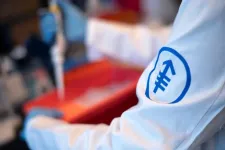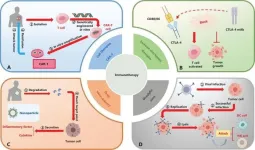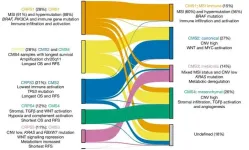(Press-News.org) With a new polymer that only attracts certain substances from solutions when electrically activated, researchers have taken a major step towards sustainable chemical separation.
A team based at the University of Illinois Urbana-Champaign has reported the first demonstration of selective electrochemical separation driven by halogen bonding in the journal JACS Au. This was achieved by engineering a polymer that modulates the charge density on a halogen atom when electricity is applied. The polymer then attracts only certain targets – such as halides, oxyanions, and even organic molecules – from organic solutions, a feature that has important implications for pharmaceuticals and chemical synthesis processes.
“Chemical separation is like making a sponge that only absorbs the chemical that you want from a mixture,” said Xiao Su, a professor of chemical & biomolecular engineering and the project lead. “While electrochemical separation is used in some contexts, it can be quite challenging to ensure that they only soak up what is needed. In this work, we have made an ‘electric sponge’ at the molecular level that only picks out particular components of mixtures.”
In industrial settings, chemical separation is often achieved through heat-based processes or membrane filtration, but these methods create material waste. Alternatives based on electrochemical mechanisms would minimize waste and benefit from sustainable sources of electricity. While such mechanisms are already used in applications like desalination, they are indiscriminate in the substances they attract.
The researchers achieved selective electrical separation with a chemical interaction called halogen bonding, in which a target molecule is attracted to redox-responsive halogen donor polymer by the strong partial positive charge on halogen atom, called the “sigma hole.” The team exploited this interaction by engineering a polymer containing a halogen iodine atom and ferrocene, an active redox center that modulates the iodine’s bonding strength when external electricity is applied. The iodine sigma hole is switched on when the ferrocene oxidizes, creating a strong positive charge that attracts negatively charged ions.
“Halogen bonding is a well-studied, if niche, area of fundamental chemistry, but our team is the first to take the concept and use it to develop a working ‘sponge’,” said Nayeong Kim, a graduate student in Su’s research group and the study’s lead author. “The strength of halogen bonding is what enables selectivity, since it picks out ions that have high affinity to the halogen atom.”
Su’s research group designed the redox-active polymer then tested it in various organic solutions. After finding that the polymer could indeed select specific ions from a mixture, the presence of halogen bonding was confirmed using nuclear magnetic resonance and Raman scattering experiments. Su’s group collaborated with chemical & biomolecular engineering professor Alex Mironenko, who led computational investigations of the polymer to understand the underlying mechanisms in the redox center’s activation.
“Now that we have demonstrated molecular electrochemical separation, the next steps will involve refining and scaling the process,” Su said. “That includes exploring scaling-up strategies, such as the cascade model, to enhance the purity of the final product, designing a continuous electrosorption system and then studying the process outside laboratory conditions.”
The study, “Redox-Responsive Halogen Bonding as a Highly Selective Interaction for Electrochemical Separations,” is available online. DOI: 10.1021/jacsau.4c00265
Vijaya S. Jeyaraj, Johannes Elbert and Sung Jin Seo also contributed to this work.
Su is also affiliated with the departments of chemistry and civil & environmental engineering and the Beckman Institute for Advanced Science and Technology at Illinois.
END
Halogen bonding for selective electrochemical separation, path to sustainable chemical processing demonstrated
2024-08-13
ELSE PRESS RELEASES FROM THIS DATE:
Study reveals urban trees suffer more from heat waves and drought than their rural counterparts
2024-08-13
NEW YORK, August 13, 2024 — A recently published study in Ecological Applications details how trees in New York City and Boston are more negatively impacted by heat waves and drought than trees of the same species in nearby rural forests. The finding, made by researchers at the Advanced Science Research Center at the CUNY Graduate Center (CUNY ASRC), highlights the challenges urban trees face in the context of climate change and underscores the importance of tailored urban forestry management as ...
New $7.7 million grant to propel search for medications for brain disorders
2024-08-13
JUPITER, Fla. — Children born with a damaged gene needed for healthy brain development, SYNGAP1, experience seizures, sensory processing disorders, difficulty speaking, intellectual disability, and autism-like behaviors. It’s a condition without any treatments, one that’s hard both on parents and children, said Gavin Rumbaugh, Ph.D., a neuroscientist at The Herbert Wertheim UF Scripps Institute for Biomedical Innovation & Technology.
Rumbaugh and a team of scientists from the institute have been awarded a five-year grant from the National Institute of Mental Health worth $7.7 million to work toward a treatment. Their goal is to ...
National Cancer Institute awards grant to Hollings researchers focused on depression among cancer survivors
2024-08-13
Depression is common among people with likely incurable cancer – understandably so. But studies have shown that it can be treated, and if the goal is for individuals to be able to engage as much as possible with family, friends, hobbies or whatever gives them joy and purpose in whatever amount of time they have, then treating depression becomes imperative.
That’s not so easy, though, as patients may face a shortage of mental health workers, difficulties with transportation and continuing stigma around mental health issues.
Evan Graboyes, M.D., a head and neck surgical oncologist and director of Survivorship ...
MSK Research Highlights, August 13, 2024
2024-08-13
New research from Memorial Sloan Kettering Cancer Center (MSK) found patients with non-small cell lung cancer brain metastases may benefit from up-front stereotactic radiosurgery; identified a connection between antibiotic use and autoimmune diseases; and uncovered a previously unknown structural role for messenger RNAs in the cytoplasm of cells.
Patients with non-small cell lung cancer brain metastases may benefit from upfront stereotactic radiosurgery
For patients with non-small cell lung cancer that has spread to the brain, targeted therapies called ...
Study finds that dopaminergic medication improves sleep quality in Parkinson’s disease patients
2024-08-13
A study involving 22 Parkinson’s disease (PD) patients has shown that use of the dopaminergic drug levodopa improves sleep quality. When the patients took the drug, the number of times they woke up during the night fell 25% and the amount of time they remained awake fell 30% on average.
The investigation was conducted with FAPESP’s support by researchers at São Paulo State University (UNESP) in Brazil, and the University of Grenoble Alpes (UGA) in France. An article reporting the results is published in ...
Breakthrough in nanotechnology: Viewing the invisible with advanced microscopy
2024-08-13
Tailoring light with Nanomaterials
Metamaterials, engineered at the nanoscale, exhibit unique properties not found in naturally occurring materials. These properties arise from their nanoscale building blocks, which, until now, have been challenging to observe directly due to their size being smaller than the wavelength of light. The team's research overcomes this limitation by employing a new microscopy technique that can simultaneously reveal both the nano and macro structures of these materials.
A New Window into the Nano World
The key finding of this research is a methodological breakthrough that enables the visualization of structures previously too small to be seen ...
Tackling cancer from the inside out: A deep dive into immune checkpoint inhibitors
2024-08-13
In the past two decades, immune checkpoint inhibitors (ICIs) have revolutionized cancer treatment, showing promising results against various solid tumors. This study reviews recent developments in ICIs, focusing on new targets like T cell immunoreceptor with Ig and ITIM domains (TIGIT), T cell immunoglobulin and mucin domain-containing protein 3 (TIM-3), and lymphocyte activation gene-3 (LAG-3). These targets aim to overcome resistance mechanisms limiting the effectiveness of current therapies, such as anti-PD-1 and anti-CTLA-4. By identifying and developing these new ...
RPI Physicist Moussa N’Gom is using light to enhance nuclear security
2024-08-13
Our nation’s security depends on the effective detection of nuclear materials at our borders and beyond. To address this challenge, Rensselaer Polytechnic Institute (RPI) physicist Moussa N’Gom, Ph.D., is leading research aimed at developing a quantum sensing probe to detect and characterize special nuclear materials precisely and without contact. Special nuclear materials are only mildly radioactive but can be used in nuclear explosives.
The research is being conducted through RPI’s participation in the Consortium ...
The atmosphere in the room can affect strategic decision-making, study finds
2024-08-13
The atmosphere within a group can influence the outcome of strategic decision-making, according to a new study co-authored by Bayes Business School (formerly Cass).
Paula Jarzabkowski, Professor of Strategic Management at Bayes, along with researchers from University of Queensland, Macquarie University and Leuphana University of Lüneburg, found that different atmospheres led to people speaking and interacting in different ways that changed how they made sense of the strategy.
For instance, when the atmosphere was pensive, people were cautious about the way to proceed, whereas, when it was curious they felt ...
Study uncovers mutated driver genes in colorectal cancer: 9 novel to CRC and 24 previously undetected in any cancer
2024-08-13
The Institute of Intelligent Medical Research (IIMR) of BGI Genomics, in collaboration with Sweden’s Uppsala University, has published the largest multi-omics study of colorectal cancer (CRC) to date. The study aimed to understand the functional and prognostic impact of cancer-causing somatic mutations, revealing new genetic alterations and developing a new molecular classifier of tumor variants. This research was published in the journal Nature on August 7th, 2024.
Unveiling New Genetic Landscapes
The researchers analyzed the whole genomes and transcriptomes ...







